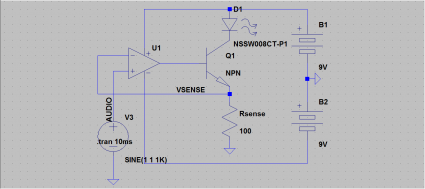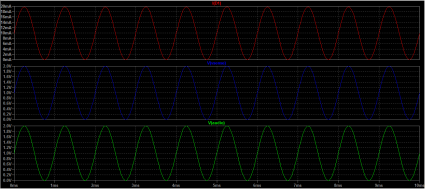I recall burning three or four weeks of a sabbatical getting Saccade.com on the air with Wordpress. So much tweaking…
LED Transmitter Schematic
Okay, so here’s the schematic for the LED transmitter circuit as I assembled this evening. I tried to write up an exposition of how it works, but frankly, it pales in comparison to the clarity and completeness of KA7OEI’s page. But here’s the basic idea: imagine that you supplied 1V to the input of the op amp. The op amp will drive the voltage at the base of the transistor so the voltage coming off the Rsense is the same (1V). When that happens, the current through Rsense (and through D1) is just 1V/100 ohms (in this case) or 10ma. And, the current is linear in the input voltage: when the voltage rises to 2V, the current is 20ma, and when the voltage drops to zero, the current is zero. So all you really need to do is take a 1V peak-to-peak audio signal, offset it by 1V (which I didn’t show on the schematic, it’s just inside the audio source node), and it will generate the appropriate current.
It’s very cool, and requires very little math to actually design. And it doesn’t matter much what the transistor is either: KA7OEI’s page uses a power MOSFET, because he is driving a much more powerful LED, but for my purposes, using an ordinary 2N3904 worked just fine.
Comments
Comment from Mark VandeWettering
Time 5/20/2011 at 2:52 pm
Not yet, but stay tuned. This weekend will see some more experimentation.
Comment from Michael Allison
Time 5/23/2011 at 3:35 pm
Mark,
It would be interesting to see what type of filtering can be done to prevent the 60 Hz hum. Examples I’ve seen are to use an optical filter with the same color as the LED or more complicated examples such as modulating a carrier to be able to filter out the interference (that makes your receiver less interesting).
You could also implement a “beam” on the receiver photo cell so it can only see the Tx LED.
Fun stuff, keep them coming.
Comment from karn
Time 12/22/2012 at 8:21 am
This might sound noobish but how to offset it by 1v?


Comment from Rune
Time 5/20/2011 at 12:57 pm
Nice little educational project. I think I’m going to the ”dollar store” tomorrow and see if i can get one of those cheap LED flashlights, and try this out. I already have a few small 1 by 1.5 inch solar cells on hand for the receiver side. Ever tried a solar cell for this?
Rune
Norway